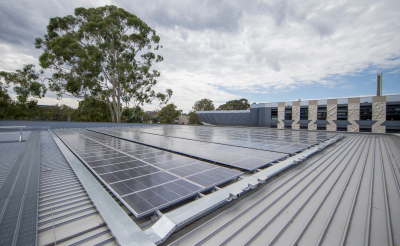Light-coloured roofs can reduce heat, while dual-sided solar panels have the potential to produce 20 per cent more energy than traditional one-sided systems on residential rooftops, new research from The Australian National University (ANU) reveals.
Dual-sided – or bifacial – solar cells allow for both the front and back of the solar panel to generate power. The back of the panel collects energy reflected from the roof. They are used in commercial solar power systems but remain underutilised in the residential solar market, where monofacial modules are more commonly used.
Monofacial solar panels generally have a white or black backsheet compared to their bifacial counterpart, which is made with glass on both sides.
Lead author of the study, Dr Marco Ernst from ANU, said the findings show the considerable benefits of dual-sided systems, while also addressing a crucial gap in understanding the viability of bifacial technology on our rooftops.
“We conducted detailed optical and electrical modelling to assess the potential energy gains of bifacial rooftop PV systems compared to monofacial arrays,” Dr Ernst said.
“Bifacial solar modules on flat rooftops have demonstrated the potential to generate up to 22.6 per cent more energy compared to monofacial solar modules.”
Cost isn’t necessarily a factor. Based on industry news, Dr Ernst said the price difference is around 10-20 per cent, but with technological advancements, the prices could end up being very similar.
“Interestingly, many of today’s monofacial panels already use bifacial solar cells as their key ingredients, and it would be reasonably easy to make the switch to bifacial solar panels,” he said.
Rooftop colour affects solar system’s performance
The research found that rooftop colour, or the roof surface’s ability to reflect sunlight, is a key factor in increasing a bifacial solar power system’s performance, and system and module design should also be carefully considered. Lighter colours typically have higher solar reflectivity.
“Rooftop reflectivity is a critical factor in maximising the potential of bifacial solar panels, emphasising the importance of considering the specific characteristics of rooftop surfaces,” Dr Ernst said.
“For example, light-coloured roofing is crucial for creating optimal reflectivity and is in line with NetZeroCities approaches.”
With record heatwaves around the world, cities are tackling the problem with innovative large-scale solutions, including painting roofs white to lower soaring heat.
In 2021, the NSW Government introduced a dark roof ban for new homes to reduce heat and energy costs, but scrapped the ban a year later as the new regulatory policy was unpopular with property developers.
“By using cool materials, such as light-coloured roofing, you can radiate heat rather than absorb it,” Dr Ernst said.
“Mainstream adoption of light-coloured roofs would reduce heat in our urban areas and energy consumption and costs, and help Australia achieve its goal of net zero emissions by 2050.”
The International Technology Roadmap for Photovoltaic (ITRPV) estimates that the world share of bifacial modules by 2033 will be 70 per cent.
“It would be in Australia’s best interest to act quickly and incentivise the use of light roofs to fight climate change and to futureproof the industry for what’s coming,” Dr Ernst said.
Government role in reducing building energy demand
“Governments have a crucial role in promoting the adoption of bifacial solar cells and light-coloured roofs due to their potential impact on household energy efficiency,” Dr Ernst said.
He said several aspects can be considered.
“Firstly, prioritising energy-efficient construction should be a cornerstone. Reducing building energy demand by incentivising good thermal insulation would be the first step. With the growing electricity demand through increase in electric vehicles and battery storage, it is becoming more important to increase energy output from homes.
“Our study highlights the largely untapped potential of bifacial panels in residential applications. Therefore, a key initiative could involve disseminating this knowledge more widely, by raising awareness among homeowners and installers about the benefits.
“I think it could also be helpful to look at what has worked well in other countries. The Buildings Energy Act in Germany is very specific about what insulation properties are required. In contrast, I think the EER-rating system in Australia is too generic and leaves too many loopholes. With very clear requirements, such as specifying the thermal insulation properties, it would benefit the end-user.”
The research has been published in Energy Conversion and Management.



